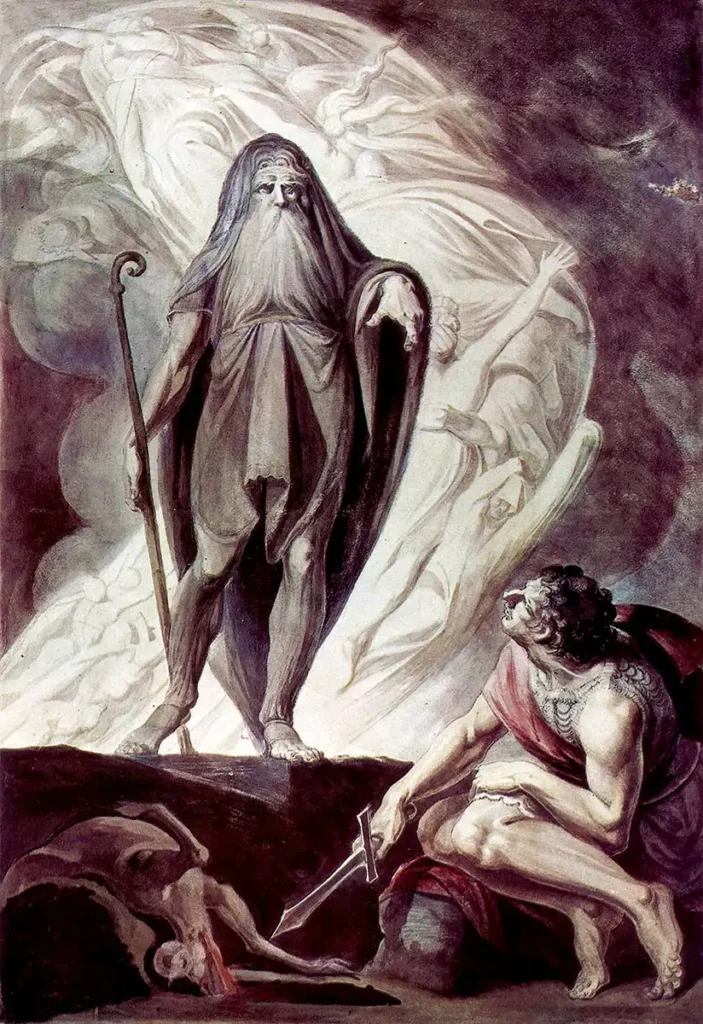“Man is the intermediary between creatures, that he is the familiar of the gods above him as he is lord of the beings beneath him”
Oration on the Dignity of Man – Count Giovanni Pico Della Mirandola (1463-94)
***
In primitive religions, continuity of life is assumed without question. The body is a temporary station for the soul, and death is a mere wavering in the unbroken family life. Both Romans and Greeks had the conception of a family soul in which all shared; this is connected with ancestor worship.
Alfred North Whitehead, from students notes, 1934
Dimensions of Belief: Ancient Myths, Philosophical Traditions, and the Christian Narrative
Throughout human history, civilizations have navigated the complex interplay between myth, philosophy, and the perception of multiple dimensions of reality. From the ancient Greeks to the Hebrews, and through to the advent of Christianity, a persistent thread weaves its way through the fabric of human thought: the belief in higher and lower realms of existence, and the expectation of a savior who would bridge these dimensions.

Myth and Reality in Ancient Civilizations
The ancient Greeks, renowned for their rich mythological tradition and profound philosophical contributions, provide a compelling example of how myth and reality were interwoven. Greek mythology is replete with gods, demigods, and heroes who traversed the boundaries between the mortal world and the divine. These stories were not mere fantasies but were integral to the Greek understanding of the cosmos. Philosophers like Plato and Pythagoras explored the idea of a reality beyond the physical world, positing the existence of ideal forms and a realm of perfect, unchanging truths.
Similarly, earlier civilizations such as Egypt and Mesopotamia possessed intricate mythologies that reflected a belief in a tiered cosmos. The Egyptians envisioned a complex afterlife journey, with the soul traversing various realms before achieving eternal peace. Mesopotamian myths, with their pantheon of gods and elaborate creation stories, also hinted at a multifaceted reality where divine and mortal planes intersected.

The ancient Hebrews, through their sacred texts and oral traditions, articulated a belief in divine realities and lesser planes of existence. The Hebrew Bible is filled with accounts of angels, visions, and divine interventions, suggesting a worldview where the material and spiritual worlds were deeply interconnected. Prophetic traditions further emphasized the anticipation of a messianic figure who would usher in an era of righteousness and divine justice.
The Advent of Christianity and the Resurrection Narrative
Against this backdrop of rich mythological and philosophical traditions, the emergence of Christianity introduced a transformative narrative. The story of Jesus Christ, particularly his resurrection, resonated with the ancient belief in higher and lower dimensions of reality. Early Christians proclaimed that Jesus, through his death and resurrection, had conquered the powers of darkness and opened the way to eternal life.
The concept of resurrection was not entirely alien to the ancient mindset. In various mythologies, gods and heroes often experienced death and rebirth, symbolizing renewal and the cyclical nature of existence. However, the Christian narrative introduced a radical shift: Jesus’ resurrection was a historical event, rooted in a specific time and place, and it carried a universal promise of redemption for all humanity.
The early Christian belief in Jesus as the awaited savior was deeply intertwined with existing messianic expectations. In the Jewish tradition, prophecies spoke of a great deliverer who would restore Israel and establish God’s reign on earth. Christianity proclaimed that Jesus fulfilled these prophecies, offering a vision of a new creation where the divine and human realms would be fully reconciled.
Philosophical and Theological Dimensions
The belief in multiple dimensions of reality, coupled with the expectation of a messianic figure, reflects a profound philosophical and theological understanding that transcends mere myth. Ancient thinkers grappled with questions of existence, the nature of good and evil, and the ultimate destiny of humanity. In this context, the Christian narrative provided a compelling answer: Jesus Christ, through his life, death, and resurrection, embodied the convergence of divine and human realities, offering a path to spiritual renewal and eternal life.
The early Christians’ emphasis on the resurrection and the coming of God’s kingdom resonated with the philosophical inquiries of the time. It addressed the human longing for transcendence, justice, and the restoration of a broken world. In a sense, the Christian message harmonized with the ancient quest for understanding the deeper dimensions of existence, while also introducing a new, transformative hope.
Conclusion
The interweaving of myth, philosophy, and theological belief in ancient civilizations set the stage for the advent of Christianity. The story of Jesus Christ, particularly his resurrection, encapsulated the ancient understanding of higher and lower dimensions of reality and the expectation of a savior. This narrative not only aligned with but also transformed existing beliefs, offering a profound vision of redemption and renewal. As we explore these ancient traditions, we gain insight into the enduring human quest for meaning and the timeless hope for a reality beyond our own.
Beezone